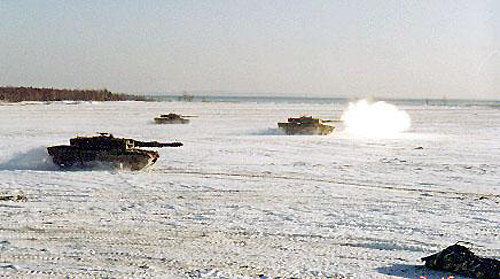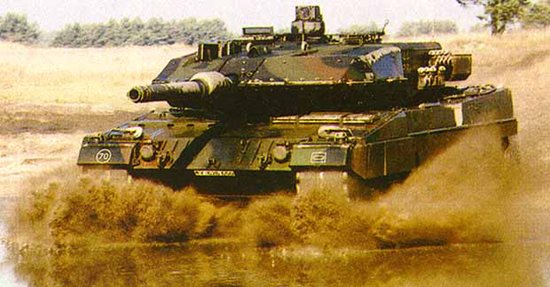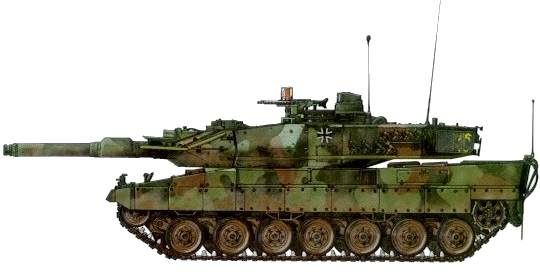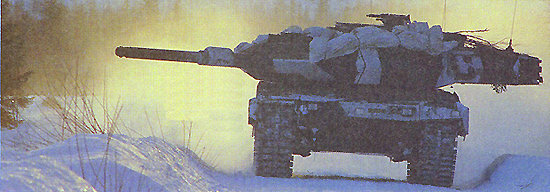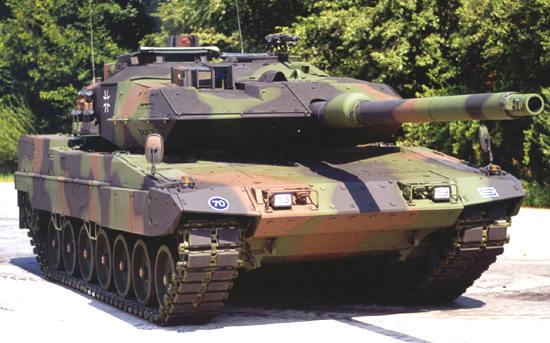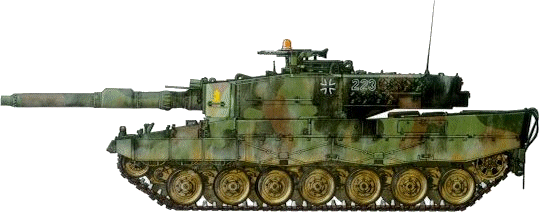
The Leopard 2 MBT began development in the 1960s, during which time the MBT/PzK-70 was still under deveopment. When it was cancelled, the German governement gave the go ahead to proceed with the Leopard 2. By 1974, 17 prototypes of this new and revolutionary main battle tank were completed, and were demonstrating that the Germans had developed a very advanced MBT with firepower, mobility, and excellent armor protection. The layout is conventional, with the driver at the front right (with some ammunition to his left), turret centered, and transmission and powerpack at rear. Initially, the prototypes were fitted with 105mm guns, however 120mm guns were fitted to later models. The main armamment is stabilized in both elevation and traverse. The Rheinmetall 120mm gun fires APFSDS and another type of fin-stabilized round, probably HE-FS or a simlilar round, and has an effective range of 2,200m. A 7.62mm MG3 MG is mounted coaxially with the main armament, and another is provided for the commander. Trials were cariied out with a British 140mm gun, and a weapon of that size could be fitted in a future upgrade of Leopard 2A5s or A6s.
The powerpack is comprised of a 1,500hp MTU MB-873 Ka-501 12-cylinder liquid-cooled diesel engine and associated transmission. It can be removed in around 15 minutes for replacement or repair. The Leopard 2 is fitted with passive night vision devices for the gunner and driver, precision laser ranging equippment for the gunner, and a stereoscopic rangefinder. NBC and heating systems for the driver's and fighting compartments are fitted as standard. The Leopard 2 can ford streams of up to 2ft 7in. without preperation, and 13ft 1in. when fitted with a snorkel. In the late 1980s, the Germans began to set in motion a new improvement program for the Leopard 2, consisting of two parts. The first part, KWS I, involved the fitting of a new 120mm 55 caliber turret, but has not been inacted as of yet. The second part of the program, KWS II, involves the fitting of new removable armor plates to the turret front and sides, increasing protection against chemical and HEAT projectiles. New armored side skirts are also fitted. A spall liner has been fitted to the inside of the turret, and electric and electronic systems have been improved considerably. Many new systems, such as a new navigation and all-electric gun control systems, have been fitted. The new proposed gun for the Leopard 2 would be a 120mm gun, 55 calibers long, allowing the use of a new APFSDS round as well as older ammunition types. Fiiting of a 140mm gun and a bustle-mounted autoloader (reducing the crew to 3) has been discussed.
Operators of the Leopard 2 include Germany, Austria, Denmark, Netherlands, Sweden, Switzerland, Finland (ex-German A4s), Poland (also ex-German A4s, and Greece (new build A6s, called the A6G). Of particular note are the Leopard 2A5s operated by Sweden. Under the local designation Strv-122 (Strv-121 being the Leopard 2A4), these Leopard 2s have been fitted with a Swedish designed armor package, Celsius Tank Command and Control System (TCCS), and an eye-safe laser rangefinder. All in all, these Leopard 2s can be considered the best in the world, even better than their German counterparts! Netherlands' Leopard 2s are being upgraded to A5 standard, as are many German examples, and Spanish Leopard 2s (Leoaprd 2A5E) are being built new to this standard. Variants of the Leopard 2 include a driver training vehicle (used by Germany and Netherlands), the Buffel armored recovery vehicle (used by the German and Danish armies), and a vehile launched bridge (also used by the Danish and German armies).

